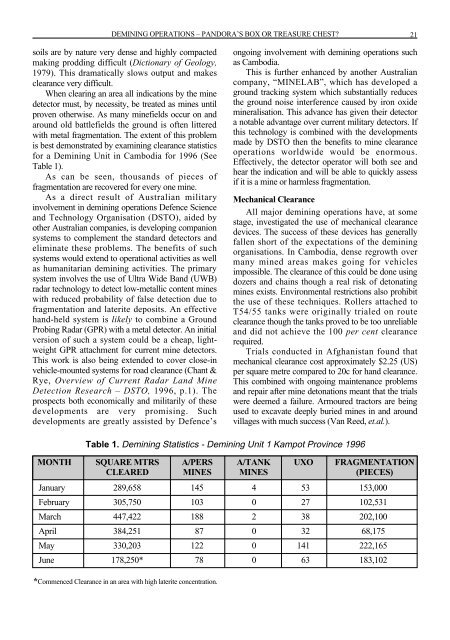ISSUE 125 : Jul/Aug - 1997 - Australian Defence Force Journal
ISSUE 125 : Jul/Aug - 1997 - Australian Defence Force Journal
ISSUE 125 : Jul/Aug - 1997 - Australian Defence Force Journal
Create successful ePaper yourself
Turn your PDF publications into a flip-book with our unique Google optimized e-Paper software.
DEMINING OPERATIONS – PANDORA’S BOX OR TREASURE CHEST? 21soils are by nature very dense and highly compactedmaking prodding difficult (Dictionary of Geology,1979). This dramatically slows output and makesclearance very difficult.When clearing an area all indications by the minedetector must, by necessity, be treated as mines untilproven otherwise. As many minefields occur on andaround old battlefields the ground is often litteredwith metal fragmentation. The extent of this problemis best demonstrated by examining clearance statisticsfor a Demining Unit in Cambodia for 1996 (SeeTable 1).As can be seen, thousands of pieces offragmentation are recovered for every one mine.As a direct result of <strong>Australian</strong> militaryinvolvement in demining operations <strong>Defence</strong> Scienceand Technology Organisation (DSTO), aided byother <strong>Australian</strong> companies, is developing companionsystems to complement the standard detectors andeliminate these problems. The benefits of suchsystems would extend to operational activities as wellas humanitarian demining activities. The primarysystem involves the use of Ultra Wide Band (UWB)radar technology to detect low-metallic content mineswith reduced probability of false detection due tofragmentation and laterite deposits. An effectivehand-held system is likely to combine a GroundProbing Radar (GPR) with a metal detector. An initialversion of such a system could be a cheap, lightweightGPR attachment for current mine detectors.This work is also being extended to cover close-invehicle-mounted systems for road clearance (Chant &Rye, Overview of Current Radar Land MineDetection Research – DSTO, 1996, p.1). Theprospects both economically and militarily of thesedevelopments are very promising. Suchdevelopments are greatly assisted by <strong>Defence</strong>’songoing involvement with demining operations suchas Cambodia.This is further enhanced by another <strong>Australian</strong>company, “MINELAB”, which has developed aground tracking system which substantially reducesthe ground noise interference caused by iron oxidemineralisation. This advance has given their detectora notable advantage over current military detectors. Ifthis technology is combined with the developmentsmade by DSTO then the benefits to mine clearanceoperations worldwide would be enormous.Effectively, the detector operator will both see andhear the indication and will be able to quickly assessif it is a mine or harmless fragmentation.Mechanical ClearanceAll major demining operations have, at somestage, investigated the use of mechanical clearancedevices. The success of these devices has generallyfallen short of the expectations of the deminingorganisations. In Cambodia, dense regrowth overmany mined areas makes going for vehiclesimpossible. The clearance of this could be done usingdozers and chains though a real risk of detonatingmines exists. Environmental restrictions also prohibitthe use of these techniques. Rollers attached toT54/55 tanks were originally trialed on routeclearance though the tanks proved to be too unreliableand did not achieve the 100 per cent clearancerequired.Trials conducted in Afghanistan found thatmechanical clearance cost approximately $2.25 (US)per square metre compared to 20c for hand clearance.This combined with ongoing maintenance problemsand repair after mine detonations meant that the trialswere deemed a failure. Armoured tractors are beingused to excavate deeply buried mines in and aroundvillages with much success (Van Reed, et.al.).Table 1. Demining Statistics - Demining Unit 1 Kampot Province 1996MONTH SQUARE MTRS A/PERS A/TANK UXO FRAGMENTATIONCLEARED MINES MINES (PIECES)January 289,658 145 4 53 153,000February 305,750 103 0 27 102,531March 447,422 188 2 38 202,100April 384,251 87 0 32 68,175May 330,203 122 0 141 222,165June 178,250* 78 0 63 183,102*Commenced Clearance in an area with high laterite concentration.
















